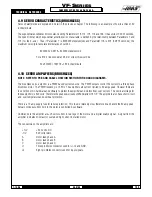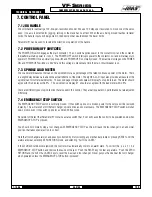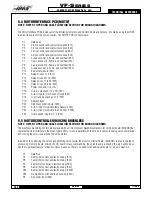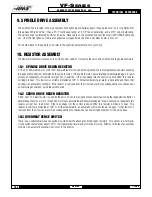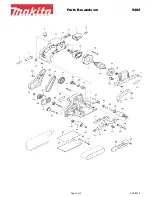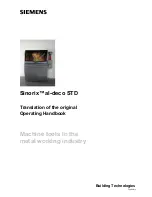
1-15-96
96-8100
151
TABLE OF CONTENTS
TECHNICAL REFERENCE
S E R V I C E M A N U A L
VF-S
ERIES
4. SERVOS BRUSH / BRUSHLESS
4.1 SERVO ENCODERS (BRUSH)
Attached to each DC servo motor, there is an incremental encoder that is 2000 lines per revolution. These encoders also
supply a Z channel pulse once per revolution. The encoders and Z channel are continuously monitored to ensure the number
of pulses matches for each revolution of the motor. If the encoders become contaminated, these pulse counts will be wrong
and an alarm will be generated. This ensures that the data from the encoders is reliable. There can never be a loss of servo
position due to accumulated encoder errors. The alarms generated will indicate that either the Z pulse occurred and the
encoder pulse was wrong or, after one and one half motor revolutions, the Z pulse did not occur.
Encoder faults can be caused by contamination of the encoder or by a wiring problem. If the encoder is contaminated, it must
be replaced. Wiring problems may be a broken wire, shorted wire, or missing shield. All wires to the encoder are enclosed
in their own shielded cable. In addition, all power wires to the motor are enclosed in a separately shielded cable. Failure of
either of these shields may cause noise in the encoder circuits and result in the encoder fault alarms.
Never connect or disconnect the servo motor cables with the control powered as this will cause an apparent encoder fault.
The servo motor encoders are differential line drivers. This means that the A, B, and Z signals are transmitted to the control
as signal pairs. A cable test is performed on these signals to ensure the differential pair are always present.
4.2 SERVO CHARACTERISTICS (BRUSH)
This machine is not capable of instantly changing speed. That is, it takes some non-zero time to accelerate and decelerate.
Acceleration and deceleration in this machine have both a constant accel/decel mode and an exponential mode. Constant
acceleration is used at the beginning of a rapid move and at the end of any move whose speed exceeds the exponential accel/
decel time constant.
Constant acceleration is a type of motion when the amount of speed change over time is constant. This constant is set by
Parameters 7, 21, 35, and 49. It has units of encoder increments per second per second.
Exponential acceleration and deceleration is a type of motion where the speed is proportional to the distance remaining in a
programmed travel. The exponential accel/decel time constant is set by Parameters 113, 114, 115, and 116. It has units of
0.0001 seconds. The speed limit at which exponential accel/decel is not available is defined by the relationship between
Parameters 7 and 113 (for the X-axis). Thus if Parameter 7 is 1200000 steps/sec/sec and Parameter 113 is 750 (0.075
seconds); the maximum velocity for accurate interpolation should be:
1200000 x 0.075 = 90000 steps/second
For a 2000 line encoder and 6 mm screw, this would be:
60 x 90000 / 33867 = 159 inches/minute
In the normal feed cutting mode, with G64 active, giving continuous cutter motion, deceleration of the axes in motion begins
at some distance away from the end point. If look-ahead has provided another motion, the acceleration for that motion will
begin at the same instant. This means that two motions, at right angles to each other, will not produce a perfectly square
Summary of Contents for VF-SERIES
Page 180: ...1 15 96 96 8100 177 TABLEOFCONTENTS TECHNICAL REFERENCE SERVICE M A N U A L VF SERIES ...
Page 235: ...96 8100 1 15 96 232 VF SERIES S E R V I C E M A N U A L ASSEMBLY DRAWINGS VF 1 COLUMN ...
Page 237: ...96 8100 1 15 96 234 VF SERIES S E R V I C E M A N U A L ASSEMBLY DRAWINGS VF 1 LEADSCREW ...
Page 239: ...96 8100 1 15 96 236 VF SERIES S E R V I C E M A N U A L ASSEMBLY DRAWINGS VF 3 COLUMN ...
Page 241: ...96 8100 1 15 96 238 VF SERIES S E R V I C E M A N U A L ASSEMBLY DRAWINGS VF 3 LEADSCREW ...
Page 245: ...96 8100 1 15 96 242 VF SERIES S E R V I C E M A N U A L ASSEMBLY DRAWINGS 3 4 2 1 ...



















